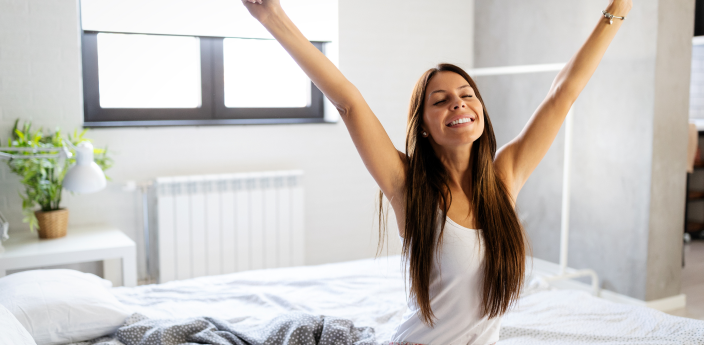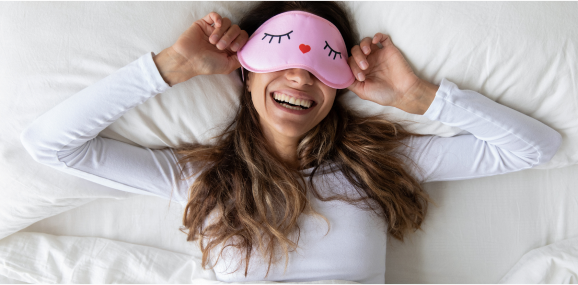If you’ve ever tried to doze off while carrying a load of physical or emotional tension, you know how difficult it can be. You need to be able to achieve a state of perfect zen — or at least relative relaxation — before you can ease yourself into sleep. That isn’t always easy.
In order to achieve the improved well-being and mental health benefits that a good night’s sleep offers, you can practice better sleep hygiene, i.e. better habits around sleep. As long as you don’t have a sleep disorder like insomnia — in which case you should consult a healthcare professional — you can practice relaxation techniques to improve your chances of drifting off.
If you need a little extra help relaxing, here are some of the top techniques you can use to make bedtime easier.
1. Progressive Muscle Relaxation
Progressive muscle relaxation is a technique that allows you to focus on and relieve the tension you’re holding within your group of muscles. By consciously tensing these muscles up and then letting the tension go, you’ll be able to better recognize where you’re holding tension.
Progressive muscle relaxation exercises focus on the following muscle groups:
- Hands, wrists, and forearms
- Upper arms and shoulders
- Muscles in the face, like the forehead and jaw
- Neck muscles
- Pectoral (chest) muscles
- Back muscles
- Abdominal muscles
- Gluteal (butt) muscles and hips
- Thigh muscles
- Lower legs and feet
With progressive relaxation, you’ll go through each muscle group one at a time. Start by taking a deep breath in and tensing up the muscles. As you exhale, release the muscle tension in that part of your body. Stay relaxed for 20 to 30 seconds, and then move on to the next group.
After you’ve relaxed each group of muscles, continue to breathe deeply and remain mindful to keep each muscle group relaxed. It should be easier to assess and maintain relaxation after you’ve acquainted yourself with each muscle group.
2. Breathing Exercises
Breathing exercises are the easiest way to encourage relaxation. You don’t need any special preparations or unique techniques to engage in deep breathing.
Taking slow, deep breaths and slowly exhaling is a great place to start. Deep breathing is known to offer great benefits, like decreasing the heart rate and reducing your overall blood pressure.
If you’re looking for a specific breathing technique to practice, try belly breathing. Belly breathing, also known as diaphragmatic breathing, engages the muscles on your lower abdomen that surround your diaphragm.
Try this exercise while lying flat on your back. Place one hand on your upper chest, at your ribcage, to assure that it remains still. Place your other hand on your belly. As you breathe in deeply, engage the muscles in your abdomen. Your belly should rise against your hand, and your chest should remain still.
As you exhale deeply, your abdominal muscles should contract. Your hand should lower with your belly. When you exhale, purse your lips like you’re drinking through a straw. This reduces the rate at which air can escape, helping you to keep your inhales and exhales shorter.
Start by doing ten deep breaths. Wait five minutes and see how you feel. If you feel the need to return to the exercise, do another ten deep breaths and wait again. If belly breathing works for you, you’re likely to be asleep before you feel the need to repeat the exercise.
3. Mindfulness Meditation
Mindfulness meditation is a very simple way to reach a relaxed state. Although some types of guided meditation may require special mats, pillows, incense, music, or even apps, mindfulness meditation doesn’t. You can do it at any time, and in practically any place.
Mindfulness meditation, simply put, is the act of noticing and letting go of your own thoughts for a clear mind. Mindfulness meditation helps you to wipe the slate clean with very minimal effort, making it more likely that you’ll be able to tackle any sleep problems that are plaguing you.
Get comfortable, close your eyes, and breathe deeply. Your thoughts will flood into your mind, just like they normally do. The goal is not to prevent your mind from wandering or even to block out your thoughts. Instead, the mental relaxation comes from the way you handle your thoughts when they approach.
Let your thoughts flow through, but don’t explore them. Let them rush over you without focusing on them or chasing them down a rabbit hole. Don’t create an internal dialogue over the things you’re thinking. Instead, just observe and be present.
Combining Mindfulness Meditation With Aromatherapy
Some people find that having something else to focus on makes it easier for them to notice and redirect their thoughts. Tools like aromatherapy can be helpful because they pass along pleasant sensory stimulation through your olfactory system.
Your olfactory system carries that information to your limbic system, which is heavily involved in your emotional response. Some scents will make you feel energized. Other scents, like lavender, may help you feel calm and relaxed.
Putting a few drops of your favorite essential oil into a diffuser can enhance your meditation experience. If you consistently redirect your focus to simply enjoying the fragrance, it’s easy to prevent yourself from getting lost in another train of thought.
4. Yoga
Yoga is a relaxation technique that improves your overall health and wellness and may aid in better sleep quality. Yoga is a gentle, low-impact form of exercise that can be enjoyed by people of all levels of fitness and physical abilities. Yoga also supports relaxation in multiple ways.
Yoga is designed to support mental and emotional relaxation with mindfulness practices and deep breathing. It promotes physical relaxation through extensive gentle stretching, which can help to alleviate tension in muscles and improve your natural range of motion.
Try incorporating yoga into your bedtime routine for a better night’s sleep. You can use free yoga videos on social media platforms and a mat or even your own carpet.
Just make sure not to exercise too vigorously or raise your body temperature too high, since these things can actually get in the way of restful sleep.
5. Journaling
Most people wouldn’t think of journaling as a relaxation technique, but it’s the perfect way to get rushing thoughts to relax. If the things buzzing around your head are keeping you up, all you need to do is let them out.
As you journal and process your feelings and thoughts, your head can quiet down. You’ll feel much more relaxed when you sort things out.
There are two great reasons to journal. The first is to process emotions. If you had a tough day or if you’re dealing with a distressing situation, journaling can serve as an outlet. You can document events, the way they made you feel, and what steps you can take to improve the situation.
The second great reason to journal is to help you organize your busy mind. If you need to keep track of what you need to do the next day, journaling can help you form a game plan and track your progress towards meeting your goals. That way, you won’t be lying awake wondering if you’ve forgotten something you need to do the next day.
6. Create a “Wind Down” Routine
If you’re busy from the time you get off work until the time you go to bed, it can be hard to switch to relaxation mode at the drop of a hat. When you’ve just spent a few hours running around to make dinner, wash dishes, prepare for the next day, and more, you’re probably still a little wound up when it finally comes time to lie down.
Strategizing your night activities can help you transition into sleep mode. Delegating chores can reduce your evening workload, and choosing the calmest activities for last can help ease your way towards sleep.
When you’ve completed your nightly chores, practice your self-care with intentionality. Take a long shower, do your skincare routine, and pamper yourself. If you make the final steps of your nighttime routine very slow and relaxing, you’ll give your mind and body enough time to wind down.
Just make sure you aren’t performing this routine at the expense of sleep. You need a minimum of seven hours of sleep each night. Pace your routine to give yourself that many hours asleep, even if it means putting off some tasks for the next day.
7. Visualization Techniques
If you’re a daydreamer, you’re already using visualization relaxation techniques. Visualization techniques involve picturing an alternative positive scenario, person, place, or thing. If you’ve always wanted to pet a unicorn, you can make that wish come true with your mind’s eye with visualization.
Come up with a scenario, real or imaginary, that makes you feel happy and relaxed. Direct your senses to imagine what it would look like, sound like, smell like, and feel like.
Throughout this process, you’re augmenting the way you feel. You’re leaving your current reality and creating a pleasant experience for yourself. Because you’re in control and the environment is purely imaginative, you’re able to guide everything to your specific liking.
8. Deep Pressure Stimulation
When you need to calm down, how does a hug make you feel? The pressure of that hug might help your body switch gears, entering a relaxed state.
This has to do with the body changing course from the sympathetic nervous system (SNS) to the parasympathetic nervous system (PSNS).
The sympathetic nervous system is your reactive nervous system. It’s the one that inspires feelings of stress, tension, or overwhelm. The “fight or flight” response you feel in stressful or tense situations is a result of your sympathetic nervous system.
Your parasympathetic nervous system is, in many ways, the opposite of your sympathetic nervous system. It’s sometimes referred to as the “rest and digest” response. When your parasympathetic nervous system dominates the response, you feel calm. Tension leaves your body, and you’re able to rest.
Deep pressure stimulation is achieved when things like firm embraces, weighted blankets, and sleep pods (like ours) provide gentle all-over compression to the body. This type of pressure encourages the SNS to relinquish control and hand it over to the PSNS, inducing relaxation and ideally leading you to a good night’s sleep.
Relax Yourself With a Hug
The Hug Sleep Pod utilizes the principles of deep pressure stimulation, but we’ve made it simple. Rather than smother your body in heavy blankets, the sleep pod is a lightweight, soft, and stretchy sleeping sack that provides gentle four-way compression to your body when you’re lying down. It holds you in like a swaddle and provides the same sensation as a calming embrace.
Snuggling into a sleep pod is one of the easiest things you can do to promote relaxation for better sleep. It’s a no-effort method that will help keep you relaxed until dawn.
Sources:
Progressive Muscle Relaxation | VA.gov
What Are the Benefits of Mindfulness? | American Psychological Association

































500,000+ happy customers